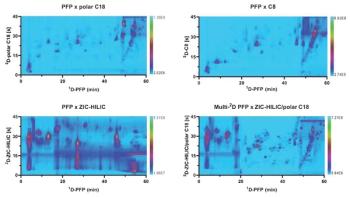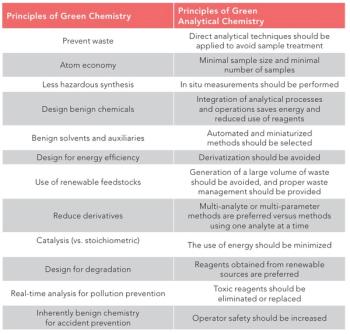
Hydrophilic Interaction Chromatography (HILIC) and Direct Online Disruption of Lipid Nanoparticles
Two proof-of-concept hydrophilic interaction chromatography HILIC) methods were developed in a joint study conducted by the University of Geneva (Switzerland), Sanofi, and the Waters Corporation—one for disrupting LNPs and retaining the mRNA, and another for detecting only unencapsulated mRNA to assess encapsulation efficiency. LCGC International spoke to Jonathan Maurer, first author of the paper that resulted from this study, about the methods and the efforts that led up to their development.
Lipid nanoparticles (LNPs) are essential for delivering messenger ribonucleic acid (mRNA) therapeutics, but assessing key quality attributes (CQAs) like mRNA integrity and encapsulation efficiency is difficult due to complex and labor-intensive methods that risk mRNA degradation. Hydrophilic interaction chromatography (HILIC) is being explored as a faster, more reliable approach. Two proof-of-concept HILIC methods were developed in a joint study conducted by the University of Geneva (Switzerland), Sanofi, and the Waters Corporation—one for disrupting LNPs and retaining the mRNA, and another for detecting only unencapsulated mRNA to assess encapsulation efficiency. LCGC International spoke to Jonathan Maurer, first author of the paper that resulted from this study, about the methods and the efforts that led up to their development.
Can you briefly explain how mRNA therapeutics work and what advantages they offer compared to traditional therapies?
It is hard to summarize how mRNA therapeutics work, as this is a very wide field composed of hundreds of innovative molecules targeting infections, cancers, and other diseases. In general, mRNA therapeutics are medicines that introduce synthetic messenger RNA (mRNA) into cells, instructing them to produce specific proteins that trigger a therapeutic response. Instead of providing proteins directly, these therapies use patient cells’ ribosomes to produce the desired protein within the cells. Then, produced proteins trigger immune responses (as vaccines), replace missing or defective proteins, or modulate disease-causing pathways.
Compared with conventional treatments, mRNA drugs can be designed and manufactured in weeks rather than months, carry no risk of genomic integration or viral replication, and allow precise control over the protein product, minimizing off-target effects. Moreover, the platform’s inherent flexibility makes it accessible for indications, from infectious diseases to cancers and rare genetic disorders, that are difficult to address with therapeutics based on small molecules or proteins.
Why is the assessment of mRNA identity, purity, and concentration crucial in the development and manufacturing of mRNA drugs?
Accurate characterization of mRNA identity, purity, and concentration underpins product safety, efficacy, and regulatory compliance. Identity confirmation—via sequencing or reverse transcription polymerase chain reaction (RT‑PCR)—guarantees the transcript matches the intended sequence, preventing production of aberrant or nonfunctional proteins. Purity evaluation ensures removal of residual DNA, enzymes, double-stranded RNA by-products, incomplete transcripts, and endotoxins, all of which can compromise stability or trigger unwanted immune responses. Precise quantification of mRNA concentration secures consistent dosing and reproducible protein expression. Together, these critical quality attributes are monitored at every stage of R&D and manufacturing to deliver a safe, effective therapeutic.
What are the main contaminants that must be removed during mRNA drug purification to ensure safety and efficacy?
mRNAs are produced by in vitro transcription, which means a polymerase assembles the nucleotides together to generate the strand, based on a DNA template. After production, the presence of several potential impurities must be controlled. Residual DNA—either plasmid template or genomic—presents genotoxic and immunogenic risks. Double-stranded RNA, frequently generated as a transcriptional by-product, potently activates innate immune sensors. Protein contaminants, including polymerases and nucleases, can provoke immune reactions, while unincorporated nucleotides and abortive transcripts may interfere with downstream applications. Additionally, bacterial endotoxins and residual buffer components or solvents must be cleared to prevent pyrogenic or toxic effects. Effective purification schemes combine enzymatic digestion, ion‑exchange or affinity chromatography, size‑exclusion steps, ultrafiltration, and buffer exchange to meet purity requirements.
What is RNA integrity, and why is it important for mRNA drug performance?
RNA integrity refers to the fraction of full-length transcripts—those possessing an intact 5′ cap and a complete 3′ poly(A) tail—compared with degraded fragments. Only intact mRNAs can be correctly translated into functional proteins; truncated or fragmented molecules fail to produce the intended protein and may activate innate immune pathways, reducing safety and efficacy. Consequently, maintaining high integrity is essential for accurate dosing, reproducible expression, and a favorable safety profile.
Which analytical techniques are commonly used to evaluate mRNA integrity, and what are their strengths and weaknesses?
Capillary gel electrophoresis under denaturing conditions delivers integrity and high-resolution size profiles, but requires specialized, costly equipment and consumables, while denaturing agarose gel electrophoresis remains a low-cost, visual method, but is qualitative and labor-intensive. For chromatography-based techniques, ion-pair reversed-phase liquid chromatography (IP‑RPLC) provides excellent separation of full-length transcripts up to ~6,000 nucleotides, though it relies on ion-pairing reagents that can contaminate LC systems and pose toxicity concerns. That is why several other LC modes, such as size exclusion chromatography, hydrophilic interaction chromatography, and anion exchange chromatography, are being explored to find alternatives. For any of these techniques, their weaknesses are the ultra-wide pore sizes needed to ensure large RNA retention, limited resolution for very large RNA (>10’000 nt), and low sensitivity for impurities in low concentrations.
What are some of the traditional methods for disrupting LNPs before mRNA analysis, and what are their limitations?
Traditional LNP disruption is performed offline by diluting the formulation with solvents or surfactants to destabilize lipid bilayers, precipitating the released mRNA, removing lipids, and resolubilizing the RNA in an aqueous buffer. Although effective, this workflow is time-consuming, dilutes the sample, reducing detection sensitivity, and increases the risk of RNA degradation, potentially biasing integrity measurements of the native product.
How does the use of surfactants impact the longevity and downstream applications of size exclusion chromatography (SEC) columns?
Surfactants can insert into the polymer matrix causing them to swell or change pore size distribution over repeated cycles. They might also weaken the cross-linking bonds holding the beads network together. All in all, this increases bead friability and backpressure, lower resolution, and change retention times. Regarding applications, residual surfactants can absorb or scatter UV light at wavelengths critical for RNA detection, necessitating additional cleanup steps or workflows avoiding surfactants.
Why do you believe that there is a need for new approaches that avoid surfactants and manual LNP disruption during mRNA analysis?
By removing manual pre-treatment and surfactant use, mRNA-LNP drug products can be injected directly, preserving native concentration and integrity of mRNA. This streamlined workflow reduces hands-on time, minimizes operator-induced variability, and yields data that more faithfully represents product integrity, while maintaining high sensitivity.
Why was hydrophilic interaction chromatography (HILIC) considered for online disruption of LNPs and mRNA analysis?
RNA and oligonucleotides are very polar molecules that are well retained on HILIC stationary phases, such as amide-coated silica. On the other hand, lipids are not retained on such stationary phases, making HILIC a good choice to separate mRNA from lipids. Now, for LNP disruption, HILIC works with high concentrations of organic solvents and elevated temperatures that destabilize the LNP structure. Thus, HILIC is a very good candidate to first disrupt the LNP structure by applying conditions that are aggressive for LNPs and then retain released mRNA cargo on the amide phase, in a single-step approach.
What advantages did your proof-of-concept HILIC method demonstrate compared to traditional sample pretreatment approaches?
Our HILIC workflow eliminates offline LNP pre-treatment, allows the direct injection of undiluted samples, and delivers integrity profiles in less than 15 minutes. The absence of pre-treatment reduces the risk of biasing integrity profiles because of surfactants, temperature, or RNAses.
What potential limitations of the current HILIC setup were identified in your study, particularly regarding the stationary phase pore size?
While oligonucleotides (< 20 nt) have a hydrodynamic radius of about 20 Å, mRNA (1000-5000 nt) has a size comprised between 100 and 200 Å. To ensure optimal interaction with the stationary phase, pore sizes should be 3-5 times bigger than the analytes. This is why ultra-wide pore columns are used in IP-RPLC for mRNA analysis. In the case of HILIC, the commercially available columns have pore sizes only up to 300 Å. While this is suitable for oligonucleotides, the size-exclusion effect can alter retention and resolution for larger species.Future work will evaluate ultra-wide-pore HILIC materials to overcome this limitation.
How did the results obtained with HILIC compare with those from orthogonal methods when analyzing commercial vaccines like Comirnaty and Spikevax?
When applied to mRNA extracted from Comirnaty and Spikevax, HILIC produced integrity profiles that closely matched those from ion-pair reversed-phase chromatography. Notably, we were happily surprised that HILIC partially resolved the dual mRNA cargo peaks (1,845 vs. 1,860 nucleotides) from a research sample that co-eluted under IP‑RPLC, illustrating its orthogonal selectivity.
Why is it important to validate this proof-of-concept method before it can be widely adopted for quality control?
Method validation is essential to demonstrate that the HILIC assay is robust, precise, accurate, sensitive, and specific for its intended purpose. Establishing performance metrics (e.g., linearity, limits of detection/quantitation, accuracy, precision) ensures regulatory acceptance and builds confidence in routine QC implementation.Future work will assess these performance metrics using ultra-wide-pore HILIC materials.
What additional factors, such as lipid-adduct formation or column robustness, still need to be evaluated?
We need more data on how lipids interact with HILIC stationary phases and whether these interactions accelerate column degradation, potentially limiting column lifetime and large-scale application. In addition, the extent of lipid–mRNA adduct formation is a critical quality attribute routinely measured by IP‑RPLC, but we currently lack evidence that HILIC can detect or quantify these species. Further studies using appropriately engineered stationary phases are required to fully elucidate HILIC’s capabilities and boundaries for assessing mRNA integrity and lipid-adduct profiles.
What improvements could be made to HILIC stationary phases to enhance their performance for large biomolecule analysis?
Currently, HILIC phases are hindered by limited pore sizes and nonspecific adsorption issues. The next widely adopted HILIC columns will undoubtedly feature ultra-wide pore architecture to effectively retain large biomolecules such as mRNA and will employ low-adsorption surface chemistries to minimize unwanted interactions, improve peak shapes, and reduce carryover.
In your opinion, how could HILIC-based methods complement or possibly replace existing techniques in the mRNA-LNP drug product pipeline?
HILIC’s polarity-based mechanism provides orthogonal resolution to the hydrophobic-driven separations of IP‑RPLC. Therefore, HILIC has the potential to resolve features in poorly separated peaks, such as integrity profiles with shoulders or multiple mRNA cargo species that IP‑RPLC might not detect. Moreover, HILIC’s online LNP-disruption capability preserves native mRNA integrity by eliminating offline pre-treatment steps. Whether this will be sufficient to bring HILIC to the forefront will depend on the availability of robust, ultra-wide-pore, low-adsorption columns designed for large biomolecules.
Reference
1. Maurer, J.; Lauber, M. A.; Fekete, S. et al. Proof of Concept Application of Hydrophilic Interaction Chromatography for Direct Online Disruption of Lipid Nanoparticles, Intact mRNA Analysis, and Measure of Encapsulation Efficiency. Anal. Chem. 2025, 97 (14), 7627-7632. DOI:
Newsletter
Join the global community of analytical scientists who trust LCGC for insights on the latest techniques, trends, and expert solutions in chromatography.




